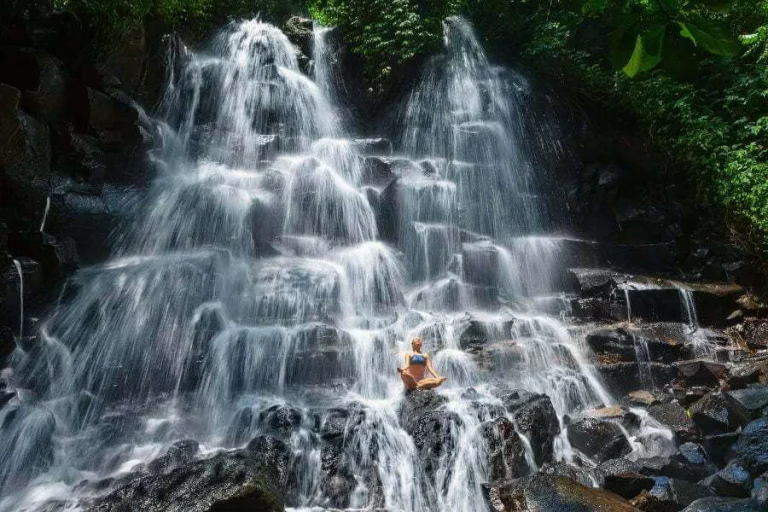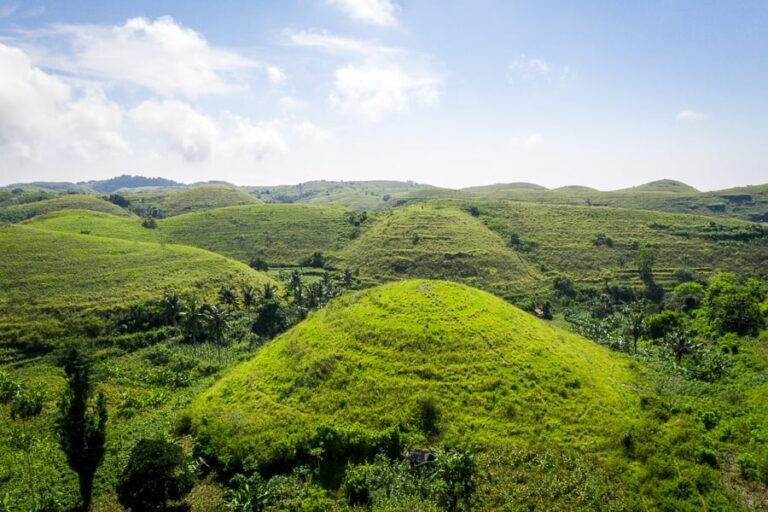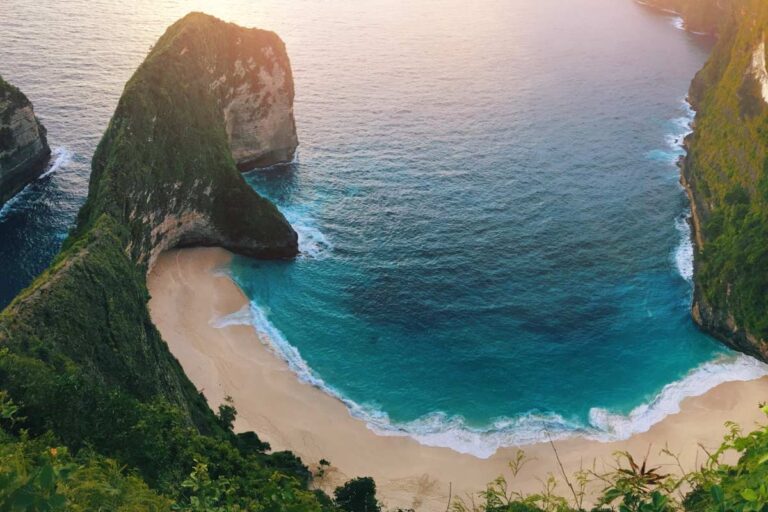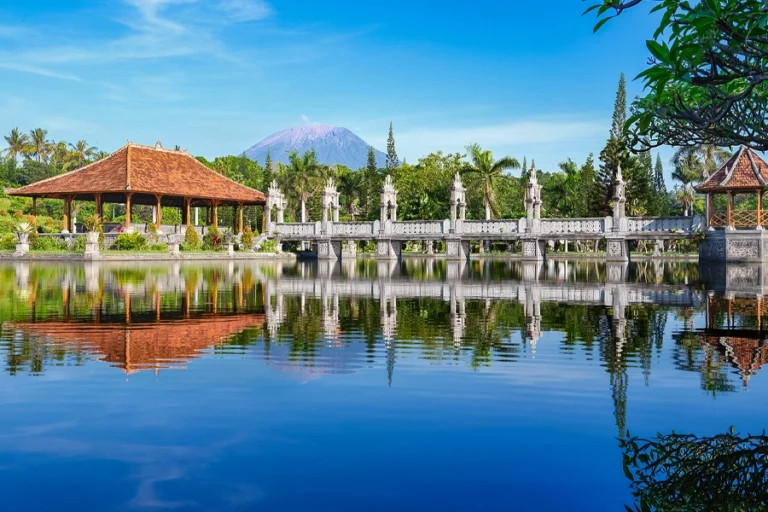Planning a trip to Bali? This 2026 travel guide covers everything you need to know—from entry requirements and weather tips to cultural etiquette and must-see destinations. Whether you’re a first-time visitor or returning for another island escape, here’s your essential pre-travel checklist.

Bali is more than just stunning beaches and scenic rice terraces — it’s a vibrant island rich in culture, adventure, and heartfelt hospitality. With tourism thriving once again and exciting new attractions emerging, there’s never been a better time to explore both its iconic landmarks and hidden corners.
Before you dive into Bali’s natural beauty and spiritual charm, understanding the island’s customs, climate, transportation, visa requirements, and cultural etiquette will help you travel smarter and deeper. Whether it’s your first time or a long-awaited return, this guide is designed to make your Bali journey stress-free, respectful, and unforgettable.
Visa & Entry Requirements for Bali in 2026
Before you land in Bali’s tropical paradise, it’s important to understand the current visa and entry policies. In 2026, Indonesia continues to simplify travel for international visitors, offering several convenient options depending on your nationality and length of stay. Here’s what you need to know:
Visa-Free Entry
Citizens of ASEAN countries — including Singapore, Malaysia, Thailand, Vietnam, and the Philippines — can enter Bali without a visa for up to 30 days. This option is ideal for short trips and regional holidays.
Note: This visa-free stay cannot be extended.
Visa on Arrival (VoA)
Travelers from over 90 countries, such as Australia, India, the United States, United Kingdom, Canada, UAE, Germany, and France, are eligible for a Visa on Arrival.
Cost: IDR 500,000 (approximately USD 35)
Validity: 30 days, with the option to extend once for another 30 days
How to Apply: Pay upon arrival at the airport or apply online before departure via the official immigration portal for a smoother experience.
E-Visa (Tourist Visa B213)
For a hassle-free arrival, travelers can apply for an e-Visa before flying to Bali. This allows you to bypass VoA payment counters and proceed directly through immigration.
Apply at: https://evisa.imigrasi.go.id/
Processing typically takes 3–5 working days.
Documents Required
To enter Bali under any visa scheme, ensure you have:
A passport valid for at least 6 months from your date of entry
A return or onward flight ticket
Proof of accommodation (hotel or villa booking)
Travel insurance is highly recommended, covering health and trip cancellations
Staying informed about the latest travel policies will help ensure your Bali experience begins without delays. For updates, always refer to the official Indonesian immigration website or consult your local embassy before departure.
Most Popular Bali Tours in 2026
Bali in 2026 continues to captivate travelers with its rich culture, dramatic landscapes, and unforgettable experiences. Whether you’re seeking adventure, spirituality, or relaxation, these top-rated tours are among the most loved by visitors this year:
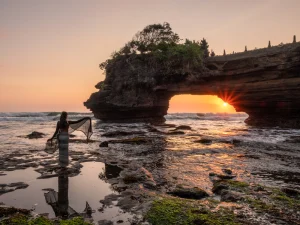
15 Best Things to Do in Bali (2025 Guide)
Bali, also known as the Island of the Gods, is a destination that offers a perfect blend of culture, adventure, and natural beauty. From sacred temples and lush rice terraces

Bali Adventure Tours – Thrills Await in Paradise
Get ready to ignite your adventurous spirit with our Bali Adventure Tours! From conquering the summit of Mount Batur at sunrise to white-water rafting through lush jungles, ATV rides across

Bali Combination Tours with Spa – Sightseeing & Serenity in One
Looking for the perfect balance of adventure and relaxation? Our Bali Tour Combination + Spa Package is designed to give you the best of both worlds. Start your day exploring

Best Affordable Bali Combination Tours for 2025
Looking for the ultimate Bali experience? Our Bali Combination Tours offer the perfect way to explore the island’s iconic temples, lush landscapes, vibrant culture, and thrilling adventures—all in one seamless

Bali Combo Activity Tours: Double the Fun, Double the Adventure
Experience the best of Bali with our Combo Activity Tours, where you can enjoy multiple exciting adventures in a single day. Perfect for thrill-seekers and explorers alike, these tours combine

Discover the Magic of Bali: Top 10 Tours and Excursions for 2025
Bali, the enchanting “Island of the Gods,” captivates travelers with its pristine beaches, lush rice terraces, sacred temples, and rich cultural heritage. Whether you’re seeking adventure, natural beauty, or cultural

Bali’s Main Destinations: Discover the Soul of the Island
Bali is more than a tropical escape — it’s a place where nature, culture, and spirituality blend seamlessly. From lush highlands to sun-soaked coastlines, the island invites you to slow down, explore deeply, and connect with something greater than yourself. These main destinations each offer a unique window into Bali’s timeless charm.
Ubud – The Cultural Soul of Bali
Tucked among jungle-covered hills and emerald rice terraces, Ubud is where Bali’s heart beats strongest. The air feels calm yet alive, filled with the sound of flowing water and traditional gamelan music. Sacred temples, artisan villages, and yoga retreats dot the landscape. The Sacred Monkey Forest offers encounters with playful macaques in a spiritual setting, while the nearby Tegallalang Rice Terraces stretch out like a living canvas of green. In the evenings, the soft lights of Ubud Palace and hypnotic dance performances offer a glimpse into Bali’s rich artistic soul.
Kuta – The Energetic Beach Playground
On the island’s southern coast, Kuta bursts with energy. This bustling beach town is known for its golden sunsets, rolling surf, and nonstop entertainment. The waves draw surfers from all over the world, while the beachfront promenade is alive with food vendors, shops, and lively bars. When the sun dips below the horizon, Kuta transforms into a nightlife hotspot with music, dancing, and an unmistakable holiday vibe.
Seminyak – Stylish by the Sea
Just north of Kuta, Seminyak offers a more refined coastal experience. Think designer boutiques, contemporary art galleries, and elegant beachfront restaurants where you can sip cocktails as the sky turns pink. The beaches here are wide and golden, with chic beach clubs providing daybeds, DJ sets, and unbeatable ocean views. It’s Bali’s fashion-forward, modern face — where relaxation meets sophistication.
Nusa Dua – Tranquil Luxury on the Peninsula
If you’re looking for serenity and upscale comfort, Nusa Dua delivers. This peaceful enclave on Bali’s southeastern tip is home to luxurious resorts, pristine private beaches, and manicured gardens. Perfect for honeymooners or families, it’s a place to unwind in style — with world-class golf, gentle waters ideal for swimming, and stunning sunrise strolls along the coast.
Uluwatu – Clifftop Drama and Spiritual Beauty
Perched dramatically above the Indian Ocean, Uluwatu is where nature’s power and spiritual reverence meet. The famed Uluwatu Temple sits on a cliff edge, where sea breezes carry the scent of incense and the sound of crashing waves. Sunset here is unforgettable, especially when paired with the fiery rhythm of a traditional Kecak dance performed against the ocean’s glow. The surrounding coastline is a dream for surfers and seekers of hidden beaches.
Sanur – Gentle Charm by the Sea
Sanur brings a slower rhythm to the Bali experience. Its calm, shallow waters and long beachfront promenade make it ideal for families and travelers seeking rest. Colorful fishing boats bob on the shore, and locals gather for sunrise walks or beachfront ceremonies. With a blend of comfort, culture, and accessibility, Sanur is a gentle introduction to the Balinese way of life.
Lovina – Northern Serenity and Dolphin Sunrises
Escape to the north and discover Lovina, a peaceful coastal town with black sand beaches and a laid-back atmosphere. Here, time moves slower. Early mornings bring dolphin-watching tours under the soft glow of dawn, while quiet evenings are spent exploring waterfalls or soaking in hot springs. It’s a place to reconnect — with nature, with simplicity, and with yourself.
Candidasa – The Tranquil East
On Bali’s eastern coast lies Candidasa, a charming village where tradition still guides daily life. The beaches are quiet, the sea is calm, and the pace is slow. From here, you can visit ancient water palaces, dive into vibrant coral reefs, or explore the nearby mountains. Candidasa is perfect for those craving authenticity and peace away from the crowds.
Nusa Penida – Untamed Beauty Across the Sea
A short boat ride from Bali’s shores brings you to Nusa Penida, a rugged island of raw, untouched beauty. Towering cliffs, hidden lagoons, and secret beaches create postcard-perfect scenes at every turn. Highlights like Kelingking Beach, Angel’s Billabong, and Broken Beach showcase nature in its most dramatic form. For underwater explorers, snorkeling and diving with manta rays add a touch of magic.
From spiritual highlands to untamed coastlines, Bali’s main destinations offer more than just places to visit — they offer experiences that linger long after your journey ends. Whether you’re chasing waves, sunsets, or serenity, Bali welcomes you with open arms and a story to tell.

Best Time to Visit Bali
Thanks to its tropical climate, Bali offers warm and inviting weather all year round. But choosing the right time to visit really depends on what kind of experience you’re looking for—whether it’s sunshine-filled beach days, peaceful retreats, or budget-friendly travel.
The dry season, running from April to October, is widely considered the best time to visit. During these months, the weather is sunny, humidity is low, and rain is rare—ideal for outdoor adventures, diving, hiking, or simply soaking up the island sun. It’s also the peak tourist season, especially in July and August, so expect busier beaches and higher prices.
If you’re after a sweet spot between good weather and fewer crowds, the shoulder months—April to May and September to October—are perfect. These transitional periods offer sunny skies and warm days, but with less tourist traffic and better deals on accommodation. It’s a great time to explore the island more peacefully while still enjoying that classic Bali atmosphere.
The wet season, from November through March, brings occasional tropical downpours and increased humidity. But don’t be too quick to rule it out. Rain often falls in short bursts, usually in the afternoon or evening, leaving the rest of the day pleasantly warm and green. It’s also the quietest time on the island, with fewer visitors, lower prices, and a lush, vibrant landscape at every turn.
In truth, there’s never a bad time to visit Bali. But for that ideal balance of sunshine, space, and value, aim for the shoulder seasons. Whether you go for the culture, the coast, or the calm, Bali promises a memorable trip whenever you arrive.
How to Get to Bali
Bali, a captivating island in the heart of Indonesia, welcomes travelers from around the world with its stunning beaches, lush landscapes, and rich cultural heritage. Whether you’re flying halfway across the globe or hopping over from a neighboring island, reaching this tropical paradise is easier than ever.
The most common and convenient way to arrive is by air. Bali’s main gateway, Ngurah Rai International Airport—also known as Denpasar Airport—is located just a short drive from the bustling tourist centers of Kuta, Seminyak, and Nusa Dua. This modern airport is well-connected to major cities across Asia, Australia, the Middle East, and Europe, offering both direct and connecting flights. Whether you’re arriving from Singapore, Sydney, Dubai, or Amsterdam, you’ll find plenty of flight options to suit your schedule.
If you’re already exploring Indonesia, domestic flights provide a fast and affordable way to include Bali in your itinerary. Frequent connections from cities like Jakarta, Surabaya, and Yogyakarta make island-hopping within the country seamless, allowing you to explore the diverse regions of Indonesia before landing in Bali’s serene embrace.
For a more adventurous and scenic approach, traveling to Bali by sea offers a unique perspective of the archipelago. Ferries regularly cross from Java to Bali via the Gilimanuk–Ketapang route and from Lombok to Bali through Padang Bai. Though slower than flying, these sea journeys offer a chance to take in coastal views and experience local life in a more relaxed rhythm.
Whichever route you choose—air or sea—Bali greets you with warmth, color, and a sense of magic that lingers long after your arrival. So gather your travel essentials, follow your wanderlust, and get ready to set foot on one of the world’s most enchanting islands.

Getting Around Bali
Once you’ve touched down in Bali, the real adventure begins. Exploring the island’s diverse landscapes—from misty mountains to sun-kissed shores—becomes part of the magic. Fortunately, Bali offers a range of transportation options to suit every kind of traveler, whether you’re chasing waterfalls, temples, or tucked-away beach cafes.
For many visitors, scooters are the go-to choice. Zipping through winding village roads and coastal highways on two wheels offers a unique sense of freedom and a chance to see the island from a more personal perspective. Scooter rentals are widely available and quite affordable, but safety is essential. Be sure to carry a valid international driver’s license and always wear a helmet. It’s a fun and flexible way to travel—ideal for confident riders comfortable navigating Bali’s sometimes chaotic traffic.
Taxis are another convenient way to get around, especially in popular areas like Kuta, Seminyak, and Ubud. They offer comfort and ease, though fares can be higher than other modes of transport. Always look for metered taxis to avoid overpaying, or better yet, use trusted ride-hailing apps like Grab or Gojek. These services are reliable, cashless, and often more affordable than traditional taxis.
For travelers seeking stress-free convenience, hiring a private driver is a popular option. Whether you’re planning a full-day tour or an entire week of sightseeing, having a local driver allows you to explore Bali on your own terms. With insider knowledge of the best routes, hidden spots, and cultural sites, a private driver can turn your journey into a personalized and immersive experience—without the hassle of parking or navigation.
Budget-conscious travelers might consider using the island’s public bus system, Trans Sarbagita. This network connects several major towns and is one of the most economical ways to travel. However, schedules can be limited and travel times long, making it less ideal for those with packed itineraries or limited time.
Whichever way you choose to explore, remember that Bali is best experienced with a spirit of patience and adventure. Embrace the slow-moving traffic, take the scenic route, and let each journey be as memorable as the destination itself.

Bali Hotels: Finding Your Perfect Haven
Bali is a place where dreams meet landscapes, and that harmony extends to its accommodations. Whether you’re drawn to the gentle hush of rice paddies or the rhythmic waves of the sea, the island offers an array of stays that reflect its spirit—from opulent resorts to intimate boutique hideaways.
The Ritz-Carlton, Bali delivers elegance in every detail. Perched along the pristine coastline of Nusa Dua, the resort treats guests to sweeping ocean views, multiple sparkling pools, and a spa experience that soothes both body and soul. It’s an ideal choice for travelers seeking comfort, exclusivity, and impeccable service by the beach.
Four Seasons Resort Bali at Sayan offers a completely different kind of luxury, one immersed in nature. Nestled deep within the lush jungles of Ubud, this serene sanctuary features private villas surrounded by tropical greenery and an iconic rooftop infinity pool overlooking the Ayung River. It’s perfect for those looking for spiritual retreat and natural beauty.
The St. Regis Bali Resort brings together timeless Balinese charm and modern sophistication. Located in the prestigious Nusa Dua area, the resort offers beachfront suites and villas, a private lagoon-style pool, and personalized butler service. It’s a seamless blend of traditional design and elegant comfort.
The Udaya Resorts and Spa in Ubud is a boutique escape that exudes warmth and charm. Surrounded by lush gardens and rice fields, this tranquil resort offers Balinese-style villas and an inviting spa. It’s a wonderful choice for travelers who want a quiet, authentic experience close to Ubud’s cultural center.
The Kayon Jungle Resort is a hidden gem nestled in a lush rainforest setting. With its cascading infinity pools, jungle-cliff views, and serene ambiance, this boutique resort in Ubud is ideal for romantic getaways or peaceful solo retreats.
Ametis Villa in Canggu offers a modern, stylish alternative for those who enjoy beach vibes and café culture. Each villa features a private pool and spacious living areas, paired with personalized butler service. It’s a top pick for couples or families wanting privacy and easy access to Bali’s surf and dining scene.
Regardless of where you choose to stay, Bali’s accommodations offer more than just a place to sleep. They offer sanctuary, inspiration, and a deeper connection to the island itself. Booking early—especially during high season—ensures your perfect haven is waiting when you arrive.

Bali Villas: Indulge in Luxury and Privacy
For the ultimate in indulgence and seclusion, Bali’s villas offer a haven of tranquility and personalized service. Whether you’re planning a romantic escape, a family holiday, or a celebration with friends, these private sanctuaries deliver an experience that blends comfort, style, and unforgettable surroundings.
Villa Kayu Raja in Seminyak offers an exceptional beachfront stay with expansive living spaces and a private pool that opens directly to the sea. The villa’s modern design, ocean views, and prime location make it ideal for families or groups looking for both luxury and convenience in one of Bali’s most vibrant areas.
The Oberoi Beach Resort, Bali is an icon of refined beachfront living. Nestled in manicured tropical gardens, its collection of private villas combines timeless Balinese architecture with modern comforts. Each villa features its own pool and direct beach access, along with world-class service and panoramic ocean views that elevate the entire experience.
Villa Atas Ombak, located in Canggu, blends modern luxury with coastal serenity. With its sleek, contemporary design, a stunning infinity pool, and black sand beach just steps away, this villa is a dream for sunset chasers and style lovers alike. It offers a seamless fusion of elegance and authentic Balinese ambiance.
Hanging Gardens of Bali redefines the jungle villa experience. Perched on a lush valley near Ubud, each villa features a private infinity pool suspended above the Ayung River Gorge. The views are breathtaking, the setting serene, and the overall atmosphere one of mystical romance—perfect for honeymoons or quiet rejuvenation.
Bambu Indah, also in Ubud, is a unique eco-luxury retreat that brings guests closer to nature without compromising comfort. Its handcrafted bamboo houses are scattered throughout the jungle, offering a sustainable stay with open-air designs, river views, and a deep connection to Bali’s natural rhythms.
Capella Ubud, Bali presents a truly one-of-a-kind villa experience. Inspired by the spirit of early explorers, this luxury tented camp blends nostalgia with elegance. Each tent includes a private plunge pool, forest views, and bespoke furnishings, offering immersive comfort in the heart of the jungle.
No matter which villa you choose, you’ll discover more than just a place to stay—you’ll uncover a private world of beauty, peace, and personalized care. Embrace the luxury, soak in the views, and let your Bali villa experience become one of the most cherished parts of your journey.

Why Visit Bali?
Bali’s allure is timeless—an island that enchants travelers with its breathtaking natural scenery, deep-rooted culture, and heartfelt hospitality. Whether it’s your first visit or a return to paradise, here’s why Bali should be on your travel list:
Breathtaking Landscapes
Bali’s dramatic landscapes, shaped by ancient volcanoes, unfold into a stunning mix of mountains, waterfalls, lush rice terraces, and pristine beaches. From sunrise hikes in the highlands to lazy afternoons by the sea, the island’s natural beauty never fails to inspire.
Vibrant Culture and Spirituality
Balinese Hinduism is woven into every aspect of daily life, filling the island with colorful offerings, ceremonial processions, and sacred art. Step into ancient temples, witness mesmerizing dance performances, and feel the spiritual heartbeat that makes Bali unlike anywhere else.
Endless Adventures
For thrill-seekers and nature lovers alike, Bali is an adventure playground. Catch world-class waves, snorkel vibrant coral reefs, explore jungle trails, or bike through emerald rice fields. Every corner of the island offers something new to discover.
Warm Hospitality
The people of Bali are known for their genuine kindness and welcoming spirit. From warm smiles to shared stories, the island offers not only beauty, but connection. You’ll feel at home, even thousands of miles away.
Gastronomic Delights
Bali’s culinary scene is a feast of flavor. Savor local favorites like Babi Guling (suckling pig), fresh seafood, or vibrant vegetarian fare, all infused with aromatic spices and tradition. From street stalls to fine dining, every meal is a celebration.
Wellness and Relaxation
A sanctuary for the soul, Bali is a global destination for wellness. Whether through yoga, meditation, or holistic spa treatments, the island invites you to slow down, breathe deeply, and restore your inner balance.
Affordable Luxury
Bali offers world-class experiences at accessible prices. Enjoy elegant villas with private pools, boutique resorts, or charming guesthouses—all delivering comfort, style, and value for every type of traveler.
Something for Everyone
Solo adventurers, honeymooners, families, or friend groups—Bali has it all. Dive into lively nightlife and local markets, or escape to peaceful villages and sacred temples. The island’s diversity makes it easy to craft your perfect trip.
Bali is more than a destination—it’s an experience. It invites you to live more fully, connect more deeply, and return home transformed. Discover the magic for yourself, and understand why Bali remains one of the most beloved places on Earth.
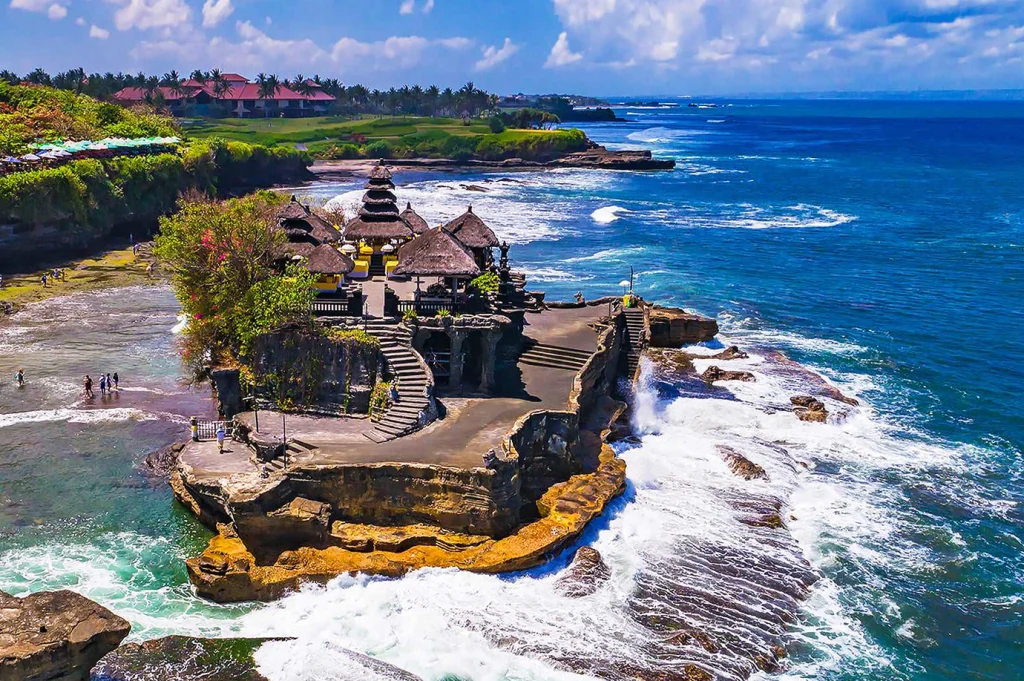
Must-Visit Temples in Bali
Bali is home to thousands of temples, each with its own charm and spiritual significance. These sacred sites not only serve as places of worship but also offer a deep insight into the island’s vibrant Hindu culture. Here are some of the most revered and frequently visited temples you shouldn’t miss:
Tanah Lot Temple
Perched on a rocky outcrop in the sea, Tanah Lot is one of Bali’s most iconic landmarks. This dramatic sea temple is dedicated to the guardian spirits of the ocean and is a popular pilgrimage site for Balinese Hindus. Visitors flock here at sunset for its breathtaking views and spiritual ambiance.
Uluwatu Temple
Located on the southern cliffs of Bali, Uluwatu Temple offers a spectacular view of the Indian Ocean. Famous for its cliffside setting, this ancient sea temple is also home to a mischievous monkey population and hosts mesmerizing Kecak dance performances during sunset.
Besakih Temple
Often referred to as the “Mother Temple of Bali,” Besakih is the island’s largest and holiest temple complex. Nestled on the slopes of Mount Agung, it consists of over 80 individual temples spread across a vast area, each dedicated to a different deity. It plays a central role in Balinese spiritual life.
Ulun Danu Beratan Temple
Floating serenely on the shores of Lake Beratan in the highlands of Bedugul, this picturesque water temple is dedicated to Dewi Danu, the goddess of lakes and rivers. Surrounded by misty mountains and reflective waters, it’s one of the most photogenic temples in Bali.
Tirta Empul Temple
Famed for its sacred spring, Tirta Empul is a holy water temple where locals and visitors alike take part in ritual purification. The temple’s pools are fed by crystal-clear springs believed to have healing and spiritual cleansing properties.
Lempuyang Temple
Perched high on the slopes of Mount Lempuyang in East Bali, this ancient complex is known for the iconic “Gates of Heaven.” Through its split gates, visitors can see the majestic silhouette of Mount Agung, creating one of Bali’s most famous photo spots.

Must-Visit Beaches in Bali
Bali’s coastline is a treasure trove of stunning beaches, each offering its own charm, from luxurious relaxation to thrilling surf and vibrant sunsets. Whether you’re after stylish beach clubs or serene shores, here are some must-visit beaches to make your Bali trip unforgettable:
Nusa Dua Beach: Luxurious Relaxation
Located on Bali’s southern peninsula, Nusa Dua Beach is famous for its pristine white sand, calm turquoise waters, and upscale resorts. It’s ideal for those seeking a peaceful, refined beach experience. Enjoy a leisurely swim, sunbathe in comfort, or try activities like kayaking and paddleboarding.
Seminyak Beach: Trendy Vibes and Sunset Spectacles
Seminyak Beach is the place for chic, cosmopolitan energy. This vibrant coastline features stylish beach clubs, upscale restaurants, and buzzing bars. Lounge on the golden sands, catch a few waves, or sip a cocktail as you watch one of Bali’s most stunning sunsets.
Kuta Beach: Surfing and Sunsets
As one of Bali’s most iconic beaches, Kuta is known for its long sandy stretch, consistent surf, and lively atmosphere. It’s a favorite for beginners learning to surf and travelers looking to mingle. In the evening, the beach transforms with vibrant nightlife just steps away.
Padang Padang Beach: Secluded Cove and Surfing Paradise
Tucked beneath dramatic cliffs on the Bukit Peninsula, Padang Padang is a small, picturesque beach reached via a narrow stone staircase. The beach is perfect for sunbathing, swimming in clear blue waters, and watching experienced surfers take on the legendary reef break.
Balangan Beach: Clifftop Views and Surfer’s Haven
Balangan Beach offers a more rustic, off-the-beaten-path vibe with a long stretch of sand framed by rocky cliffs. Surfers flock here for the waves, but it’s also ideal for relaxing under the sun or enjoying sweeping ocean views from the cliffs above.
Nusa Lembongan: Island Paradise
Just a short boat ride from Bali, Nusa Lembongan boasts some of the most beautiful beaches in the area. Dream Beach and Mushroom Bay are favorites for swimming, snorkeling, and lounging, while Devil’s Tear impresses with its dramatic waves crashing against rocky cliffs.
Whether you’re a surfer chasing the perfect wave or a traveler seeking serenity by the sea, Bali has a beach to match your mood. Each shore promises something special—inviting you to explore, relax, and soak in the tropical magic.

Must-Visit Waterfalls in Bali
Bali’s lush interior is home to some of the most stunning waterfalls in Southeast Asia. From hidden gems nestled deep in the jungle to easily accessible cascades near popular towns, each offers a unique glimpse into the island’s raw natural beauty.
Sekumpul Waterfall: The Majestic Multi-Tiered Cascade
Located in North Bali, Sekumpul is often considered the island’s most beautiful waterfall. A collection of seven powerful cascades flows down steep, jungle-covered cliffs. Reaching Sekumpul requires a scenic trek through rice fields and bamboo groves, but the breathtaking view and cool plunge pools at the base make it more than worth the effort.
Gitgit Waterfall: The Iconic North Bali Gem
One of Bali’s most accessible waterfalls, Gitgit is located near the main road in North Bali. With a 35-meter drop into a lush, green ravine, it’s a favorite stop for families and first-time visitors. The trail is well-maintained, making it easy to enjoy the misty beauty and calming sound of the falls.
Banyumala Twin Waterfalls: A Hidden Oasis
Tucked in the highlands of Munduk, Banyumala features two parallel streams that fall gracefully into a natural pool. The hike can be slightly challenging, but you’ll be rewarded with a quiet, serene setting perfect for swimming and photography. This off-the-beaten-path destination is a hidden paradise for waterfall lovers.
Tegenungan Waterfall: A Picturesque Cascade Near Ubud
Just minutes from central Ubud, Tegenungan is one of the most popular waterfalls in Bali. Its strong, wide flow makes it a dramatic sight, and the surrounding jungle adds to its allure. Easily accessible with paved stairs and viewing platforms, it’s a favorite for quick getaways and scenic selfies.
Tukad Cepung Waterfall: The Sunlit Cave Waterfall
A truly magical sight, Tukad Cepung is hidden inside a cave, where sunlight filters through the top to illuminate the falling water. The trek to reach it includes walking through a river and between rocky canyon walls, offering an adventurous and Instagram-worthy experience.
Tibumana Waterfall: The Serene Jungle Retreat
Located near Bangli, Tibumana is a peaceful single-drop waterfall surrounded by dense jungle. The short and easy trail through palm groves leads to a secluded pool perfect for a refreshing dip. Its tranquil atmosphere makes it ideal for meditation, relaxation, and nature appreciation.
Kanto Lampo Waterfall: The Unique Photogenic Cascade
Set in Gianyar, Kanto Lampo is a tiered waterfall that flows over stepped black rocks, creating a stunning fan-like effect. Easy to access and ideal for photos, it’s especially popular with locals and photographers. The shallow river and gentle flow make it a safe spot to wade and explore.
Whether you’re chasing powerful falls or looking for peaceful jungle escapes, Bali’s waterfalls promise natural beauty and unforgettable experiences at every turn. Bring your camera, wear comfortable shoes, and get ready to discover the island’s wilder side.

Brief History of Bali
Bali’s history is a rich tapestry woven from ancient traditions, powerful kingdoms, and cultural resilience. The island’s earliest evidence of human life dates back to the Paleolithic era, with stone tools and artifacts hinting at its prehistoric past.
Over the centuries, Bali fell under the influence of major Southeast Asian empires, most notably the Srivijaya and later the Majapahit Empire from Java. These connections brought Hinduism and Buddhism, which blended seamlessly with local animist beliefs to form the island’s unique spiritual and cultural identity.
The 14th and 15th centuries marked Bali’s golden age under the Majapahit, with flourishing art, literature, and temple architecture that continue to define Balinese aesthetics. When the Majapahit Empire declined, Bali became a refuge for artists, priests, and nobles, preserving much of Java’s classical culture.
European contact began in the 16th century, and by the 19th century, Dutch colonial forces had gained control. The Balinese fiercely resisted foreign domination—most famously through the tragic Puputan (mass ritual suicides) in the early 20th century, acts of defiance that underscored their devotion to cultural sovereignty.
Bali became part of the newly independent Indonesia in 1949. The following decades saw a cultural revival and the rise of tourism, particularly from the 1960s onward, transforming the island into a global travel destination.
Today, Bali maintains a delicate balance between ancient traditions and modern influences. Its history remains central to its identity—an enduring story of creativity, devotion, and resilience.
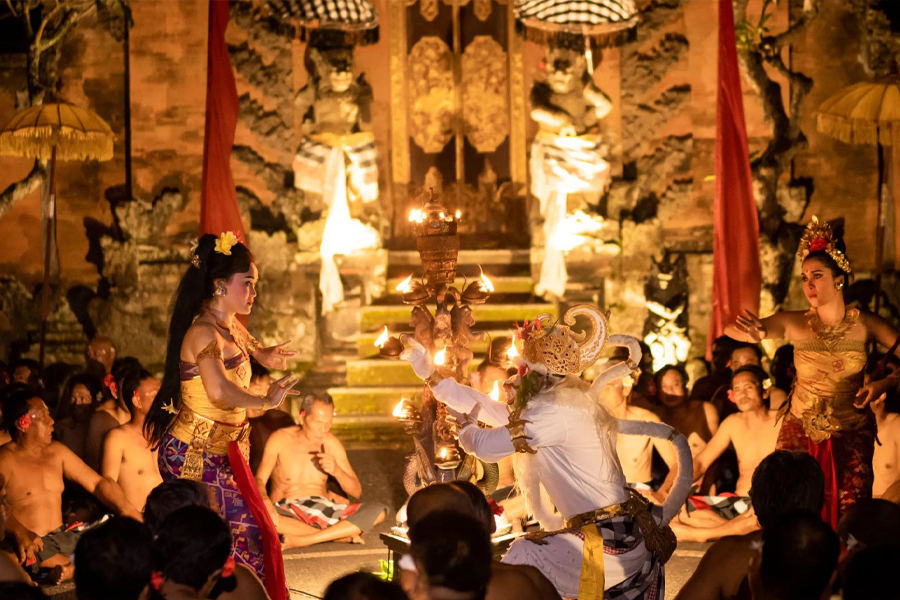
Cultural Significance: The Soul of Bali
Bali’s charm extends far beyond its natural beauty—what truly sets the island apart is its rich, living culture. Deeply rooted in Hindu traditions, Balinese culture is a vibrant tapestry of spirituality, art, and communal life, woven seamlessly into daily routines and celebrations.
Tri Hita Karana: The Philosophy of Harmony
At the heart of Balinese life is Tri Hita Karana, the guiding principle of harmony between humans, nature, and the divine. This philosophy shapes everything from architecture and agriculture to rituals and community interactions, fostering a deep sense of balance and respect.
Temples: Sacred Spaces of Devotion
Temples, or pura, are central to spiritual and social life in Bali. With thousands scattered across the island, each adorned with stone carvings and colorful offerings, temples host countless ceremonies that reflect the island’s devotion and artistic spirit.
Arts and Crafts: Expressions of Skill and Tradition
Bali is famed for its handcrafted artistry. Whether it’s intricate wood carvings, stone sculptures, silverwork, or batik textiles, these works showcase generations of skill, creativity, and cultural storytelling passed down through families.
Traditional Dances: Stories in Motion
Dance is a powerful form of expression in Bali. Performances like the Kecak, Barong, and Legong blend mythological storytelling with precise, stylized movements, offering a glimpse into the island’s sacred narratives and performing arts.
Community and Family: Foundations of Balinese Life
Strong kinship and community cooperation define the Balinese way of life. Ceremonies—be it weddings, cremations, or temple festivals—are shared experiences, reinforcing unity and cultural continuity across generations.
Festivals and Celebrations: Rhythm of the Island
Bali’s calendar is rich with festivals like Galungan, Nyepi, and Odalan, each a vivid display of music, dance, offerings, and devotion. These moments bring the island to life with processions, rituals, and an atmosphere of joyful reverence.
The Spirit of Bali: Welcoming and Warm
Balinese hospitality is heartfelt and sincere. Visitors are often welcomed as part of the community, invited to experience local customs, and treated with kindness that leaves a lasting impression.
Preserving Culture in a Modern World
Despite modernization and the growth of tourism, Bali remains deeply committed to preserving its cultural heritage. Community-led efforts, educational programs, and sustainable tourism practices are helping to protect the island’s identity for future generations.
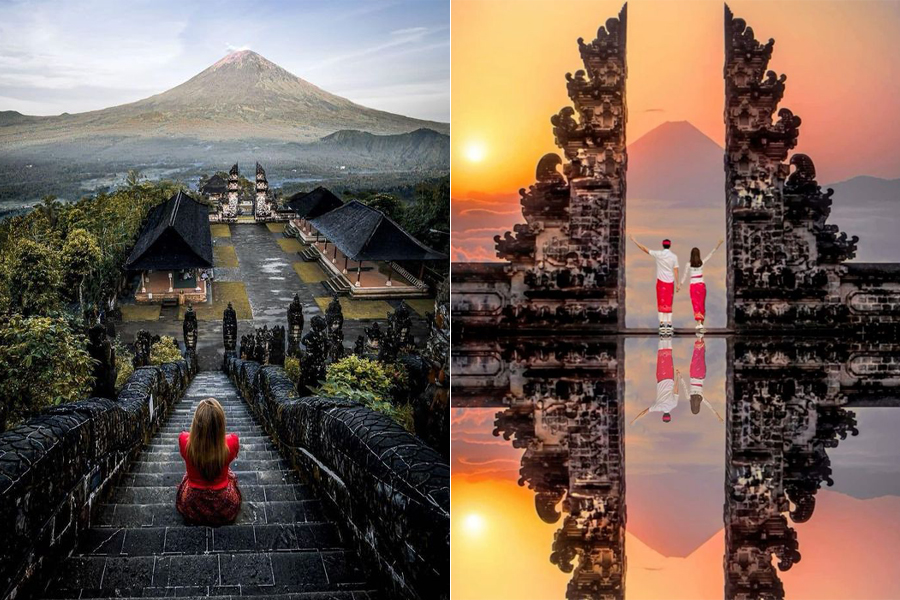
Bali’s Most Instagram Spots
Bali’s ethereal beauty and captivating culture make it a photographer’s dream. From ancient temples and dramatic cliffs to rice terraces and sunrise hikes, here are some of the island’s most Instagram-worthy spots:
Gates of Heaven, Lempuyang Temple
Capture the iconic shot of Mount Agung perfectly framed between the split gates of Lempuyang Temple. Arrive early to catch the mystical morning light and the famous mirror-like water reflection.
Tegalalang Rice Terraces
Wander through Ubud’s lush rice terraces for photos filled with vibrant green hues and breathtaking landscapes. The traditional Balinese irrigation system and scenic footpaths make for a stunning backdrop.
Kelingking Beach, Nusa Penida
Snap a photo of the iconic T-Rex-shaped cliff jutting into turquoise waters. The view from above is absolutely striking, and if you’re adventurous enough, hike down for a rare beach shot few can claim.
Bali Swing
Fly high above the jungle canopy and capture that heart-racing moment mid-air. With lush green forests below and tropical vibes all around, it’s a guaranteed showstopper on your feed.
Sunrise at Mount Batur
After a pre-dawn trek, watch the sky transform with glowing orange and purple hues as the sun rises over Lake Batur. The summit views, volcanic landscape, and soft light are perfect for dramatic shots.
Tirta Gangga Water Palace
This serene former royal palace features tranquil pools, stepping stones, and stone statues — an elegant, symmetrical dream for photographers. The water reflections and ornate fountains add to the charm.
Wanagiri Hidden Hill
Pose on whimsical swings, bird’s nests, or bamboo platforms overlooking Lake Buyan and the misty hills. This playful spot in North Bali is perfect for romantic or adventurous Instagram moments.
Rumah Pohon Tree House, Nusa Penida
Climb to this treehouse perched on a cliff for panoramic views of the ocean and surrounding cliffs. It’s a hidden gem that offers rustic charm, epic landscapes, and a one-of-a-kind photo op.

Must-Visit Hot Springs in Bali
Bali’s natural beauty extends beyond its beaches and rice terraces. Beneath the island’s volcanic surface lie therapeutic hot springs, where mineral-rich waters bubble to the surface, offering a deeply rejuvenating experience for both body and soul. Here are some of the island’s most beloved hot springs worth visiting:
Banjar Hot Springs: A Tranquil Oasis in North Bali
Nestled in the lush hills of northern Bali, Banjar Hot Springs is a serene retreat surrounded by tropical gardens. The site features multiple pools with varying temperatures, fed by natural sulfur springs believed to ease muscle tension and promote skin health. The beautifully carved stone dragon spouts add a traditional Balinese charm to the experience.
Toya Bungkah Hot Springs: A Volcanic Soak with a View
Set on the edge of Lake Batur, Toya Bungkah offers dramatic views of the active Mount Batur volcano. Here, you can soak in steaming geothermal pools while gazing across the lake’s calm waters and the surrounding caldera. The setting is especially magical at sunrise, making it a perfect post-hike treat after climbing Mount Batur.
Angseri Hot Springs: A Hidden Gem in the Mountains
Tucked away in the mountains of Tabanan, Angseri Hot Springs offers a secluded escape amidst bamboo groves and rice terraces. The spring features both public and private pools, as well as a charming waterfall. The peaceful atmosphere makes it ideal for visitors seeking a more off-the-beaten-path wellness experience.
Belulang Hot Springs: A Local Favorite in the West
Located in Mengesta village, Belulang Hot Springs is a simple yet charming spot, favored by locals for its quiet ambiance and healing waters. The sulfuric spring flows through a stone spout into a modest bathing pool surrounded by rice paddies, offering a truly authentic Balinese experience.
Air Panas Penatahan: A Natural Wonder in the North
Set along the Yeh Ho River in Penatahan village, this hot spring offers a picturesque setting complete with private soaking tubs and riverside views. The mineral-rich water is known for its curative properties, and the tranquil environment makes it an excellent spot for rest and rejuvenation.

Where is Bali?
Bali, a jewel nestled in the heart of the Indonesian archipelago, is one of Southeast Asia’s most beloved travel destinations. Known for its lush landscapes, vibrant culture, and warm hospitality, this tropical island welcomes travelers from across the globe year-round.
By Air: The Easiest Way to Get to Bali
The quickest and most convenient way to reach Bali is by flying into Ngurah Rai International Airport (DPS), also known as Denpasar Airport. Located near the lively tourist area of Kuta, this modern airport is the island’s primary international gateway. It receives direct and connecting flights from major cities around the world, including Singapore, Kuala Lumpur, Tokyo, Sydney, Dubai, London, and New York. Whether you’re coming from Asia, Europe, Australia, or the Americas, there are numerous flight options to suit your travel plans.
From Within Indonesia: Domestic Flights
If you’re already exploring Indonesia, getting to Bali is simple via domestic flights. Major airlines operate regular routes from cities such as Jakarta, Surabaya, Yogyakarta, and Makassar. These short flights—typically one to two hours—are affordable and frequent, making it easy to include Bali in a broader Indonesian adventure.
By Sea: Scenic Ferry Connections
For those seeking a more adventurous journey, ferries provide an alternative way to reach Bali. Regular routes connect Java and Lombok to Bali’s eastern ports.
From Gilimanuk (Java) to Padang Bai (Bali)
From Lembar (Lombok) to Padang Bai (Bali)
These ferry rides offer stunning views of the surrounding islands and provide a budget-friendly option for island-hopping travelers.

Things To Do in Bali
Trekking and Hiking: Bali offers scenic trekking routes through lush rainforests, rice terraces, and volcanic landscapes. Conquer Mount Batur for a breathtaking sunrise hike, or explore hidden waterfalls in Munduk and Sekumpul for a refreshing jungle adventure.
Surfing and Water Sports: Bali is a world-famous surf destination, home to legendary breaks in Uluwatu, Canggu, and Kuta. Beginners can take lessons at gentler beaches, while other water activities like snorkeling, diving, and paddleboarding await across the island.
Cycling: Discover the Balinese countryside on two wheels. Pedal past vibrant rice fields, traditional villages, and scenic routes in areas like Ubud and East Bali, where cycling tours often include cultural stops and local interactions.
White-Water Rafting: For adrenaline lovers, white-water rafting on the Ayung or Telaga Waja rivers offers both excitement and scenic beauty. Paddle through lush gorges, jungle canopies, and cascading waterfalls on a thrilling journey through Bali’s interior.
Temple Visits: Bali is dotted with thousands of temples that blend spiritual significance with breathtaking architecture. Visit Tanah Lot for its oceanfront views, Besakih Temple on Mount Agung for its grandeur, or Uluwatu Temple for sunset and cultural performances.
Traditional Dance Performances: Experience Bali’s rich storytelling tradition through captivating dances like the Kecak, Barong, and Legong. These performances, often held at temples or cultural centers, are a highlight of any cultural immersion.
Art Villages: Bali’s creativity thrives in artisan villages such as Ubud for painting and wood carving, Celuk for silver jewelry, and Batubulan for stone sculpture. These centers preserve age-old techniques and welcome visitors to witness and shop directly from local makers.
Cooking Classes: Learn the secrets of Balinese cuisine with hands-on cooking classes that often start with market visits. Prepare traditional dishes like sate lilit, lawar, and nasi campur while gaining insight into local ingredients and techniques.
Yoga and Meditation Retreats: Bali is a wellness sanctuary, especially in Ubud and Canggu. Join daily yoga sessions, meditation classes, and holistic retreats surrounded by tranquil rice fields or jungle views, perfect for inner healing and balance.
Spa Treatments: Indulge in traditional Balinese spa experiences using natural herbs and oils. From relaxing massages and scrubs to flower baths and reflexology, Bali’s spas offer luxurious pampering that nourishes both body and soul.
Beachside Bliss: Relax on Bali’s idyllic beaches, whether it’s the calm waters of Nusa Dua, the surf-ready waves in Canggu, or the trendy sands of Seminyak. Enjoy swimming, sunbathing, or just listening to the ocean’s soothing rhythm.
Shopping: Bali’s markets and boutiques offer a treasure trove of souvenirs, handicrafts, and fashion. Explore the vibrant art markets of Ubud and Sukawati, browse designer boutiques in Seminyak, or discover unique finds in local villages.
Nightlife: When the sun sets, Bali comes alive with a dynamic nightlife scene. Dance the night away in Kuta, sip cocktails at beach clubs like Potato Head or Finns, or enjoy live music and laid-back lounges in Seminyak and Canggu.
Day Trips: Venture off the beaten path with day trips to nearby destinations like Nusa Penida, Nusa Lembongan, or the highlands of Bedugul. Discover hidden waterfalls, serene temples, scenic lakes, and authentic village life.

Must-Visit Markets in Bali
Ubud Art Market: Located in the heart of Ubud, this sprawling market is a treasure trove of handicrafts, souvenirs, clothing, and artwork. Wander through the labyrinthine alleys, haggle for unique finds, and immerse yourself in the vibrant atmosphere filled with traditional Balinese charm.
Sukawati Art Market: This expansive market near Gianyar is a bargain hunter’s paradise, known for its wide selection of affordable souvenirs and locally made handicrafts. From intricate wood carvings and vibrant paintings to colorful textiles and home décor, it’s a great place to find authentic Balinese treasures.
Pasar Badung: As the largest traditional market in Bali, Pasar Badung in Denpasar offers a fascinating glimpse into everyday Balinese life. Stalls brim with fresh produce, herbs, spices, textiles, and household goods, making it the perfect spot to observe local commerce and sample traditional snacks.
Pasar Seni Kumbasari: Located beside the Badung River in Denpasar, this bustling market transforms into a vibrant night scene filled with lights, aromas, and energy. Explore rows of stalls selling handcrafted souvenirs, clothing, and accessories, and don’t miss the chance to try a variety of Balinese street food specialties.

